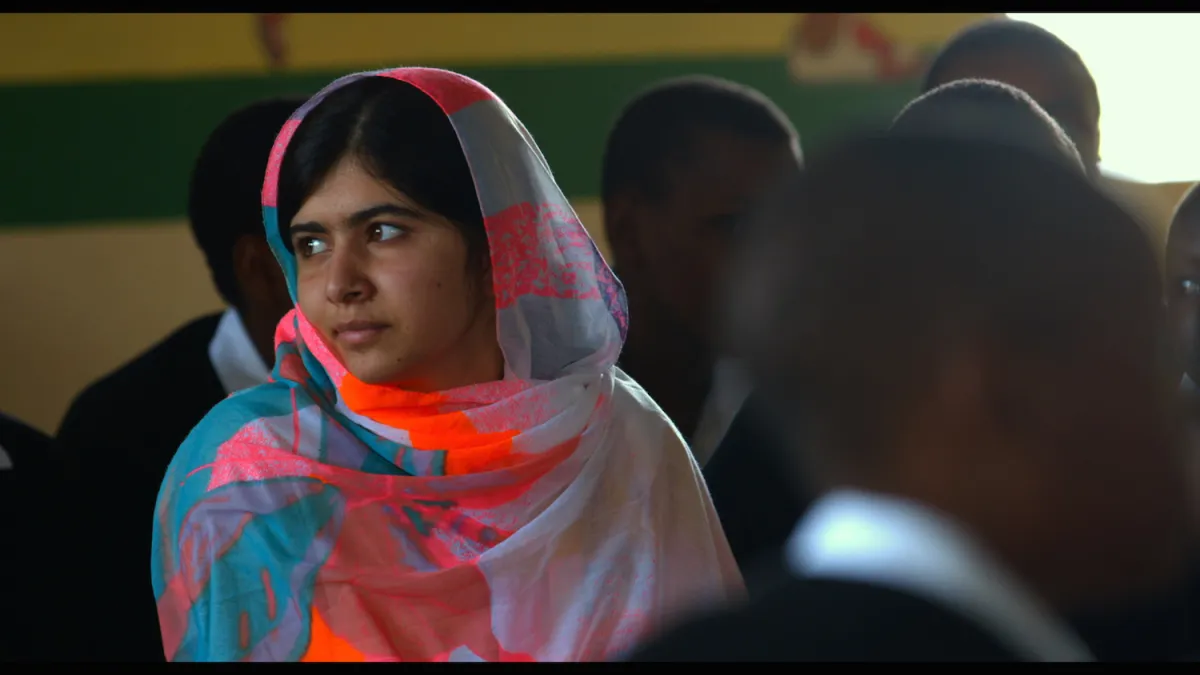Director David Guggenheim hasn’t necessarily made a great film. But he has definitely made an important film about a great subject. And a film which feels so timely and vital, that the movie doesn’t need to be technically brilliant to be worth seeking out and wisely combines educational intention with an emotional throughline. The film will be used in plenty of schools and shown at events, and audiences touched by Malala Yousafzai’s story will certainly be inspired. Guggenheim’s access to Malala Yousafzai, and interest in telling her story, is all that is really needed…even if Guggenheim stumbled across an original approach but doesn’t go all the way.
Malala Yousafzai was named after a 19th Century Afghan national hero, teenager Malalai of Maiwand, who fought and rallied the soldiers in the fight against the British, with speeches, including a now infamous speech (which has been borrowed and paraphrased) “It is better to live like a lion for one day then to live like a slave for a hundred years.” Malala introduces the film by explaining the story behind her name, and the shocking parallel that although there is a 140 years between them, both teenage girls who spoke up were shot immediately after. But Malala Yousafzai survived this horrific attack, and continued to share her message. She has been forced to leave her home in Pakistan and her family now resides in England, as she and her father are still wanted by members of the Taliban.
Her father, Ziauddin, the “he” in the film’s title, speaks of the disbelief and guilt for allowing his daughter to speak publicly against the Taliban’s ban on female education…despite his daughter’s insistence that she made the choice to speak completely independently. Honestly, the father-daughter story in this film is definitely when the film is strongest. The intimacy of these narratives, and hearing her father speak with such pride about his daughter’s feminism, is incredibly moving. Ziauddin’s love for education (as a teacher) and encouraging his daughter to truly be educated started her down her path to greatness. He didn’t make her who she is, he simply helped her become the remarkable woman she is today. When asked how her life would be different without education, Malala tells Guggenheim she would likely have two children and be illiterate.
The focus on the Yousafzai family is arguably the best part of the film and most engaging, partially because it allows us to observe how different Malala is with her family compared to when in the public eye. We hear her talk about celebrity crushes and fighting with her brothers and bad grades in school. All things which should not be remarkable, accept these were all aspects of her life the Taliban wanted to stamp out with their policies. And the juxtaposition of her in public life is surprising to see from a young woman of 16, talking about education with poise and authority.
As much of the story is about her life in Pakistan before nearly being killed as it is about her life now. These are stories told with beautiful animation and narrated by Malala and her father. It is a good way to illustrate the stories, considering how little footage is available, but also adds a sense of poignancy. This is the story of a girl who should not have had to think of such things in her young life. She is resilient and brave and smart, but her childhood has been stolen because of the need to have a girl her age speak out on behalf of other girls from around the world. You always have in the back of your mind, there is a lot of pressure which has been put on this young woman, far more than one should have to take on.
He Named Me Malala is a documentary which wants to tell Malala and her family’s story in an intimate and inspiring way, and the way Guggenheim does this may not result in a great technical documentary, but it does make for a powerful one that looks at Malala’s influence as a force for change. But both Guggenheim and Malala remind us that this change hasn’t happened yet…this films is a tribute, but it’s also an unapologetic call to action.
y Coffin is a New York transplant from the midwest. She is the New York-based writer/podcast editor for Filmoria and film contributor at The Interrobang. When not doing that, she’s writing books on classic Hollywood, including Lew Ayres: Hollywood’s Conscientious Objector and her new book Hitchcock’s Stars: Alfred Hitchcock and the Hollywood Studio System.
—Please make note of The Mary Sue’s general comment policy.—
Do you follow The Mary Sue on Twitter, Facebook, Tumblr, Pinterest, & Google +?









Published: Oct 11, 2015 11:12 am